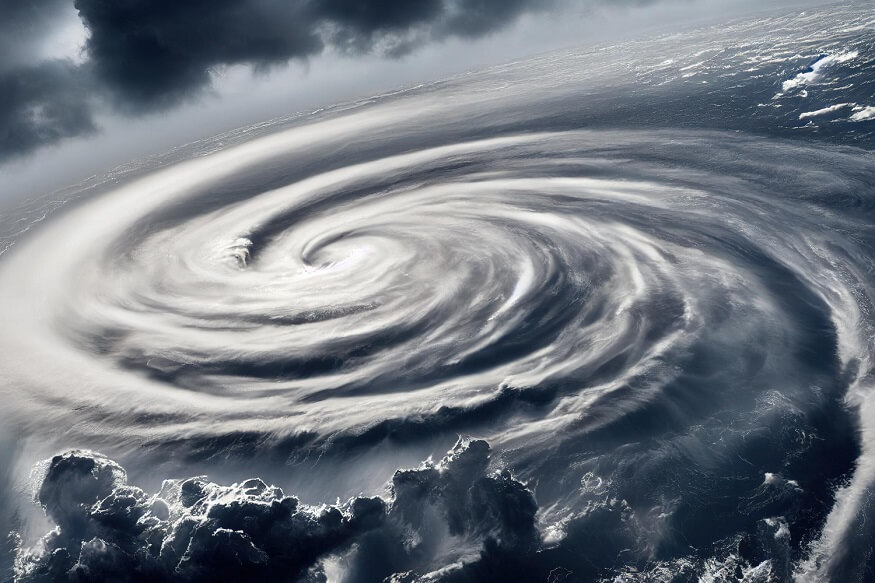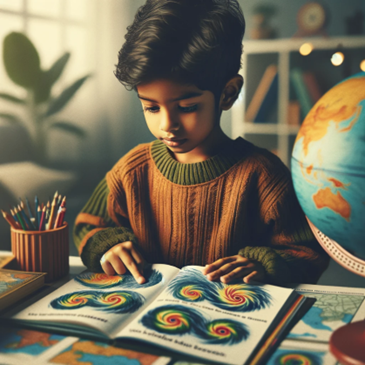What is a Cyclone? Causes, Stages & Types

A cyclone can be defined as a big mass of air that rotates and arises around a low-pressure area. Low pressure areas are places where the air pressure is lesser than normal. The word “Cyclone” was developed from a Greek word called “Cyclos”, which was coined by Henry Paddington and refers to coils of a snake.
In a nutshell, cyclones begin their journey as a phantom. You cannot see them at the start. They quietly travel the world on their own. But slowly, their quietness turns into fury. They become larger and larger, twisting, and swirling and desperately reaching the sky from the grounds. What is invisible in the beginning becomes a huge monster that destroys anything on its path.
How are cyclones formed?
For cyclones to form, many elements need to come into play. Temperature, the earth’s rotation, the ocean’s surface, and many other factors play an important role in a cyclone’s formation. Cyclones typically form over ocean waters near the equator. The sea’s surface temperature needs to be 26.5°C or higher. When the warm, wet air rises from the ocean’s surface, it leaves an empty space or an area of low pressure underneath it. This empty space or low-pressure area sucks in moist air, which rises and cools. This further forms clouds and releases heat.
This is when the earth’s rotational powers step in. As the earth is continuously turning, the air doesn’t rush straight in. It spins around, like water going down a drain and as this spinning air gains momentum, it creates a large-scale circle of wind spinning around. This is also called the Coriolis Effect. The cyclones rotate counterclockwise in the Northern Hemisphere and clockwise in the Southern Hemisphere.
Did you know? – The Coriolis Effect occurs due to the Earth’s rotation. It makes objects moving in a straight line appear to be curved but it is mostly noticeable in massive movements like air masses and ocean currents. The Coriolis Effect affects many things like weather patterns and influences the rotational direction of cyclones.
Cyclones usually form at the 30 degrees north and south latitude. However, the equatorial region remains safe from cyclones due to zero latitude and a lack of Coriolis effect. The larger the Coriolis force, the greater the probability of a cyclone incident in warm or heated seawater.
As a cyclone becomes bigger and intensifies, it undergoes many stages. Gear up to enter the swirling stages of a cyclone!
For you: Enrol your child in India’s leading preschool network.

Different Stages of a Cyclone
Cyclones love playing games just like kids and play in 8 different stages of varying speeds and intensities. Hop on board to understand the various stages of a tropical cyclone.
Stage 1 – Tropical Disturbance
The first stage of a cyclone begins as a cluster of thunderstorms that form over warm ocean waters. You cannot see any spinning around in this stage.
Stage 2 – Tropical Depression
In this stage, you can see a spinning pattern with steady winds of up to 61.15 kilometres per hour or 33 knots. A knot is a unit of speed used in maritime and aviation, in which, one knot is equal to 1.852 kilometres per hour and one nautical mile the same as 1.852 kilometres.
Stage 3 – Tropical Storm
As the steady winds reach 34 to 63 knots, the process is referred to as a tropical storm and is given a name at this point.
Do you know what tropical cyclones are? Tropical cyclones are named by following the rules set at the regional levels. In the Southern hemisphere, which is the Indian ocean and South Pacific, cyclones are named in alphabetical order with women’s and men’s names being alternated.
Stage 4 – Type 1 Cyclone
When the steady winds reach 64 to 82 knots, it is known as a Category 1 cyclone in the Southwest Indian Ocean and South Pacific. In this stage, trees and homes are damaged that can also lead to minor flooding cases in the coastal areas.
Stage 5 – Type 2 Cyclone
In this stage, the steady winds reach 83 to 95 knots. At this level, the cyclone can cause great damage.
Stage 6 – Type 3 Cyclone
At this stage, the cyclone is labelled a major one. As the sustained winds range from 96 to 112 knots, these storms can cause devastating damage.
Stage 7 – Type 4 Cyclone
This stage can cause catastrophic damage to the entireecosystemit meets. The storm is extremely dangerous and the sustained winds reach 113 to 136 knots.
Stage 8 – Type 5 Cyclone
The final stage of the cyclone, sustained winds reach 137 knots and are reserved for the most intense and fatal storms.
For you: Visit EuroKids to start your child’s early education.
Where do cyclones occur in India?
The spiral movements of the cyclone can become extremely powerful and cause winds, rainfall, harsh storms, and devastating damage in the coastal areas. The classification and naming convention of a cyclone depends on the region. For instance, in the Western North Pacific they are known as typhoons while in the Eastern North Pacific they are referred to as hurricanes. In the Southwest Indian Ocean, they are called cyclones.
Did you know? – Each year about 85 storms form over warm tropicaloceansacross the globe.
Depending on the type, cyclones are also classified as typhoons or hurricanes. In India, cyclones occur over the coastlines in both the eastern and western sides. In fact, the Bay of Bengal is one of the most active cyclone basins in the world. Some of the states that get affected by cyclones include West Bengal, Odisha, Andhra Pradesh, and Tamil Nadu. Although less prone to cyclones compared to the Bay of Bengal, the Arabian sea, which lies on the western side of India also sees cyclones, mainly during pre- and post-monsoon periods. States like Kerala and Karnataka are also states affected by these cyclones.
Staying Safe During cyclones
Do you know how to stay super safe when a cyclone comes swirling your way? Explore these 7 must know tips that can help keep you super safe during cyclones:
- Stay informed and keep a constant tab on weather updates from credible and verified sources.
- Familiarize yourself with shelters and evacuation routes and plans designed by your local government.
- Close all your windows and doors and reinforce them with sturdy materials like plywood.
- Stock emergencies supplies like food, medical kits, water, non-perishable food, important documents, batteries, and flashlights.
- Turn off gas, electricity, and water supplies to prevent potential hazards.
- Charge all devices beforehand and only use them for emergencies.
- Try to stay calm and only venture out when authorities declare it safe to do so.
Conclusion
Cyclones are powerful forces of nature that cause mass destruction. They are huge air masses that swirl and rise around a low-pressure area. We learned how the Coriolis effect influences the rotational speed of the cyclone. The regions frequently affected by cyclones in India are West Bengal, Odisha, Andhra Pradesh, and Tamil Nadu. We also learned about different levels and stages of cyclones to be aware of when the first signs occur and take precautionary measures accordingly.
Now that you have understood about cyclones, share this information with your friends and family. Be the champion of cyclone safety!
- References:
- https://ndma.gov.in/Natural-Hazards/Cyclone
- https://oceanservice.noaa.gov/education/tutorial_currents/04currents1.html#:~:text=Because%20the%20Earth%20rotates%20on,image%20for%20a%20larger%20view.
- https://ugm.ac.id/en/news/ugm-expert-explains-mitigation-measures-for-tropical-cyclone-anggrek/#:~:text=along%20wind%20movement.-,Dr.,in%20warm%20or%20hot%20seawater
For informative and accurate articles on all things related to your new born-toddler’s development, growth, health and nutrition, follow EuroKids Blogs and do check out our nationally recognized preschools – EuroKids for the first step in your kid’s educational journey! – after references, in the bottom of the article
About Us
EuroKids is recognized as India’s most respected early childhood education brand, with over 21 years of experience, and has a presence in 350+ cities & 3 countries. The journey began in 2001 with 2 preschools and since then the group has consistently raised the bar for preschool education through its innovative and mindful curriculum – EUNOIA, which helps children grow holistically in a home-like environment.
